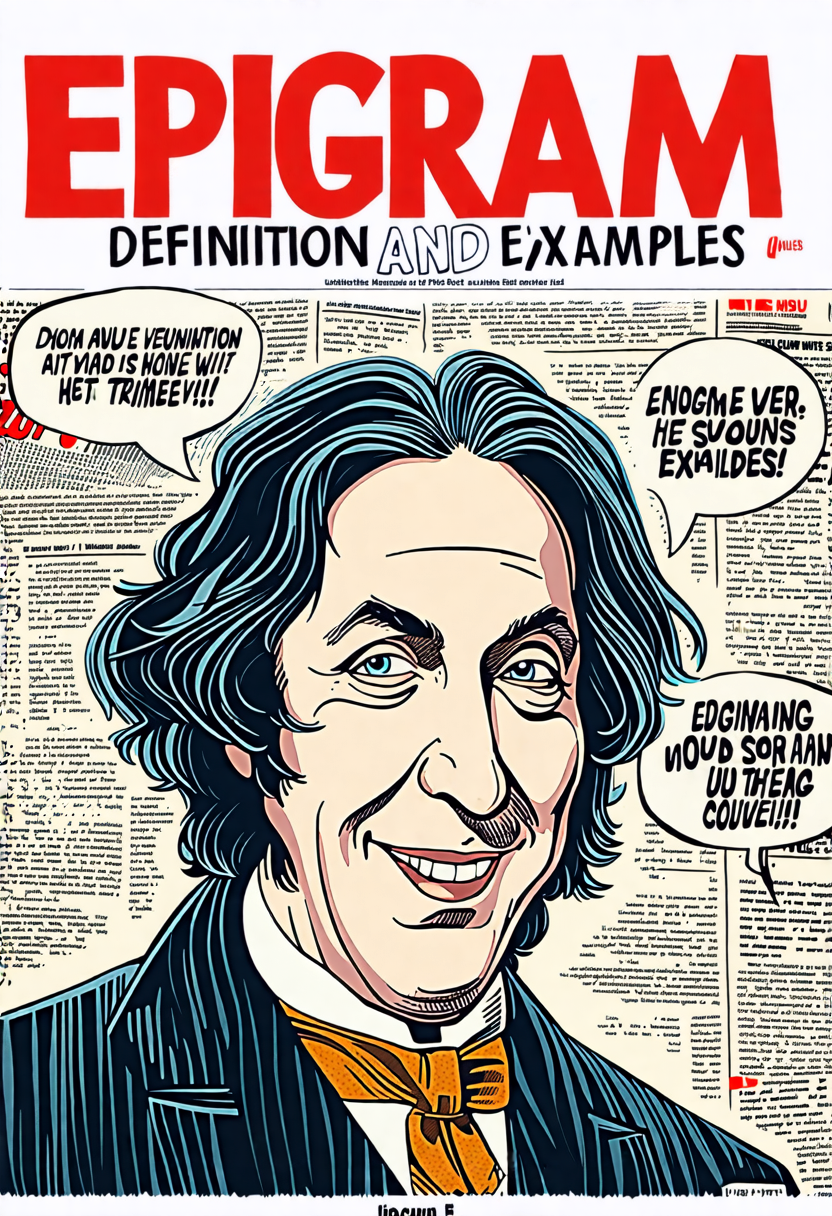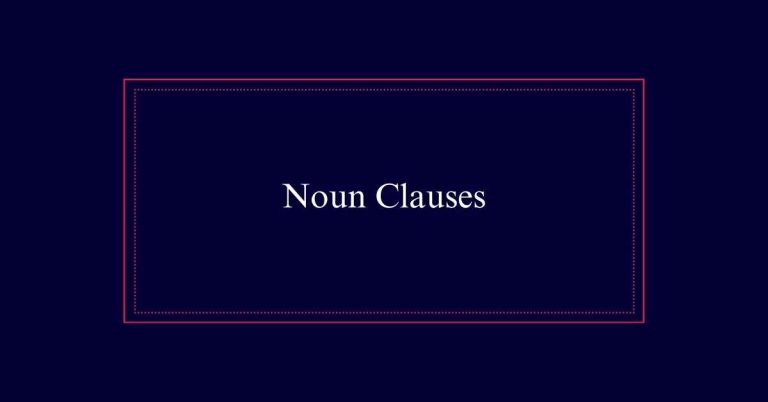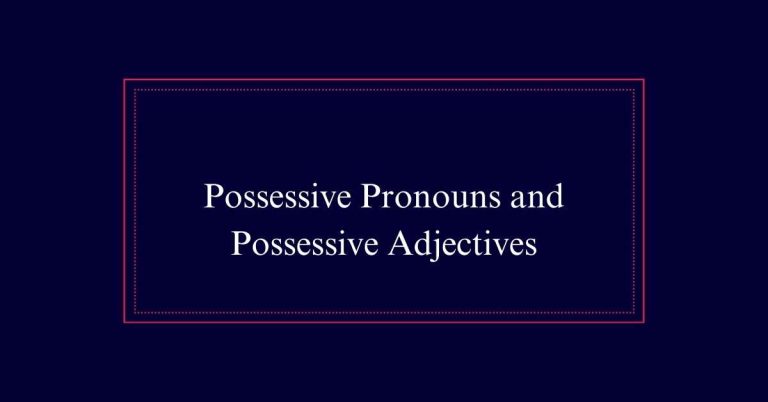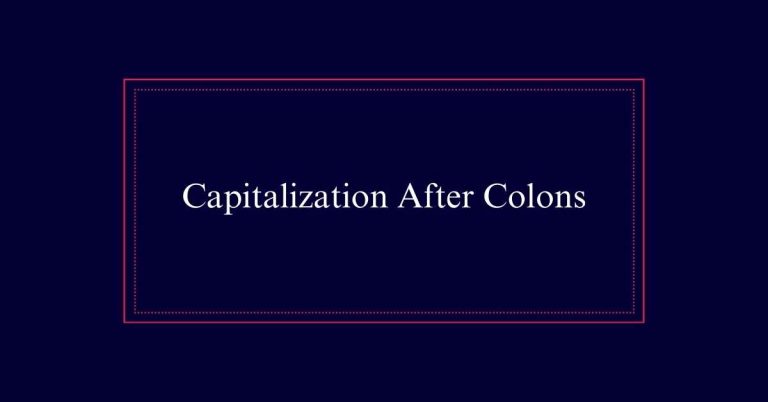Epigram: Definition and Examples
An epigram is a brief and witty statement that captures insightful observations or clever thoughts. Known for its brevity and wit, an epigram often includes a twist or punchline, making it memorable and thought-provoking. Originating from ancient Greek poetry, it has been utilized by notable figures like Oscar Wilde and William Shakespeare.
Historically, epigrams were inscribed on monuments and gravestones and have been used in political discourse for their impactful delivery. Famous examples include Alexander Pope’s “To err is human, to forgive divine,” and Oscar Wilde’s “I can resist anything except temptation.”
What Is an Epigram?
An epigram is a brief and witty statement that captures a thought or observation with clarity and precision. Typically, it is a short, catchy phrase or saying. Epigrams can be serious, inspiring, or humorous. They are often designed to include a twist at the end, adding an element of humor or irony.
Politicians frequently use epigrams in speeches to create impact, while writers employ them to grab attention and convey ideas concisely. Historically, epigrams were used on monuments and gravestones. Today, they are found in poetry, political speeches, and literature.
Characteristics of Epigrams
Epigrams captivate with their brevity, wit, and insightful observations. These literary devices are marked by their concise nature, often including a surprising twist or punchline that leaves a lasting impression. Epigrams are versatile, appearing in poetry, speeches, and literature, and they often highlight irony or humor. Their succinctness allows for quick communication of complex ideas, making them a powerful tool for writers and speakers alike.
| Feature | Description | Example |
|---|---|---|
| Brevity | Short and concise | ‘Brevity is the soul of wit.’ |
| Wit | Clever and humorous | ‘I can resist everything except temptation.’ |
| Insight | Deep observations | ‘A witty saying proves nothing.’ |
| Twist | Surprising ending | ‘If you are not a myth, whose reality are you?’ |
| Versatility | Various uses | Found in poetry, literature, speeches |
Historical Usage
Throughout history, the charm and impact of epigrams have been harnessed by various cultures, starting with ancient Greek poets. The earliest epigrams were inscriptions on monuments and gravestones, often conveying poignant thoughts or tributes.
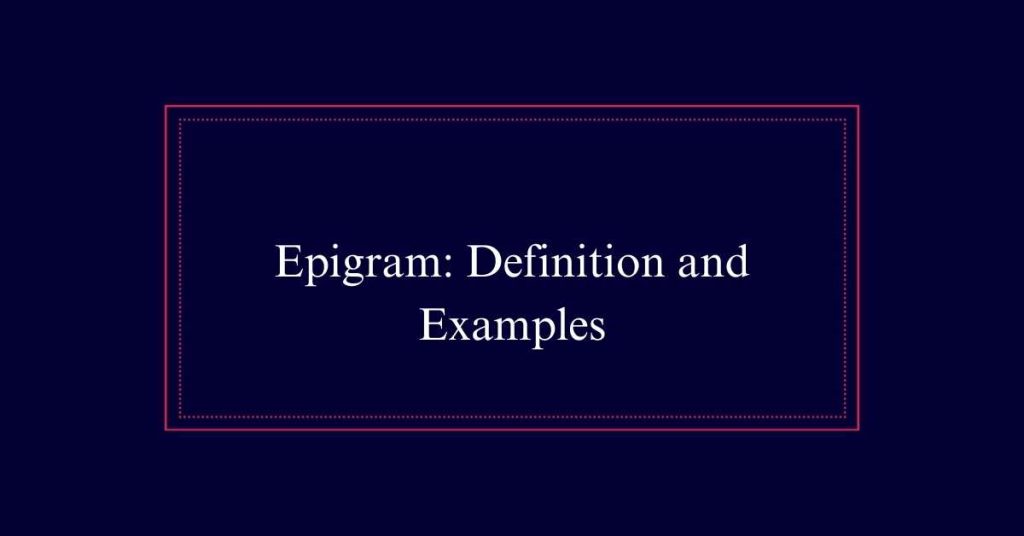
Greek poets like Simonides and Martial popularized them, transforming simple inscriptions into a refined literary form. The Romans embraced epigrams, using them in both public and private contexts to express wit and wisdom concisely.
During the Renaissance, epigrams found a revival in Europe, with writers and thinkers incorporating them into their works to comment on society and human nature. Over centuries, epigrams evolved but retained their core appeal—offering sharp, memorable insights in just a few words.
Epigrams in Literature
Literary authors often employ epigrams to enrich their narratives with sharp, memorable insights. These succinct phrases can effectively encapsulate complex ideas or themes within a few words.
Writers like Oscar Wilde and William Shakespeare are renowned for their use of epigrams. Wilde’s “I can resist everything except temptation” and Shakespeare’s “Brevity is the soul of wit” are prime examples. Such epigrams capture the essence of characters and situations, adding layers of meaning. They also provide readers with striking, thought-provoking moments.
Political Epigrams
In political discourse, epigrams serve as potent tools to convey messages with clarity and impact. Politicians often use these succinct, witty statements to capture the essence of their ideas and leave a lasting impression on their audience.
The significance of epigrams makes them easy to remember and repeat, which is vital in political campaigns where sound bites can sway public opinion. Famous examples include Abraham Lincoln’s “Government of the people, by the people, for the people” and Winston Churchill’s “Never was so much owed by so many to so few.”
Epigrammatic Twist
An epigrammatic twist often adds humor or irony, making the phrase more memorable and impactful. This twist usually appears at the end, transforming the statement into something unexpected. It creates a punchline effect that surprises the reader, adding depth and wit.
For example, Oscar Wilde’s epigram, ‘I can resist everything except temptation,’ uses the twist to highlight human frailty with humor. The twist can also offer a new perspective on a familiar idea, making the epigram more thought-provoking.
It is this clever turn of phrase that distinguishes an epigram from a simple statement, ensuring it lingers in the mind. Writers and speakers use this device to engage audiences and convey messages effectively.
Epigrams Vs. Epigraphs
Often confused, epigrams and epigraphs serve distinct purposes in writing. An epigram is a witty, concise saying or poem, often with a twist, used to convey clever sentiments. An epigraph, however, is a quotation placed at the beginning of a book or chapter to set the tone or thematic context. Both are brief and impactful but serve different roles.
| Aspect | Epigram | Epigraph |
|---|---|---|
| Definition | Witty saying or poem | Quotation at the beginning |
| Purpose | Convey clever sentiment | Set tone or thematic context |
| Usage | Literature, speeches, poetry | Books, chapters |
| Typical Length | Short, a few lines | Brief, can vary in length |
Famous Epigrams
Many famous epigrams have stood the test of time and continue to resonate with audiences. These short, witty statements often carry profound truths.
For instance, Oscar Wilde’s ‘I can resist everything except temptation’ humorously highlights human frailty. Shakespeare’s ‘Brevity is the soul of wit’ captures the essence of concise expression. Voltaire’s ‘A witty saying proves nothing’ cleverly criticizes superficial cleverness without substance. Sun Ra’s ‘If you are not a myth, whose reality are you?’ poses a deep philosophical question. John Cage’s ‘If something is boring after two minutes, try it for four’ challenges our patience and perception.
Why Use Epigrams?
Understanding why epigrams are used sheds light on their powerful impact in communication. Epigrams distill complex ideas into memorable, concise statements. This makes them effective in capturing attention and conveying messages quickly. Their brevity guarantees that they are easily remembered and shared, amplifying their influence.
Epigrams also add a layer of wit or irony, sparking thought and engagement from the audience. In speeches, they can highlight key points, making the message more persuasive. In literature, they encapsulate themes or emotions succinctly, enriching the reader’s experience.
The combination of brevity, wit, and depth makes epigrams a versatile tool in both written and spoken forms, enhancing the effectiveness of communication.
How is the word “is” used in an epigram?
An epigram’s wit shines brightly when the word “is” is used with deft precision. This part of speech is crucial for conveying the clever message concisely. In just a few words, the “is” delivers impact and humor, revealing the essence of the epigram.
Crafting Your Own Epigrams
Creating your own epigrams involves mastering the art of distilling complex ideas into sharp, memorable phrases. Start by identifying a core idea you wish to convey. Think about how you can express this idea in a concise manner. Aim for brevity without losing the essence of your message.
Incorporate a twist or an element of surprise to make it memorable. Humor, irony, and clever wordplay are effective tools. Use simple, yet impactful, language. Review examples from renowned authors like Oscar Wilde and Voltaire to understand their techniques.
Practice regularly by trying to summarize various thoughts into single, punchy lines. Over time, your ability to craft compelling epigrams will improve, making your writing more engaging and thought-provoking.
